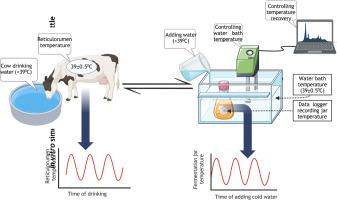In vitro simulation of drinking events in cattle
IF 1.9
Q2 MULTIDISCIPLINARY SCIENCES
引用次数: 0
Abstract
Drinking causes a rapid decline in reticulorumen temperature (RT) followed by an exponential recovery, which may potentially impact the reticulorumen ecosystem. However, the nexus between drinking events and their effects on ruminal fermentation and microbial diversity has not yet been studied, either in vitro or in vivo. Although artificial (in vitro) rumen systems are widely used in ruminant research to simulate the reticulorumen environment, no such simulation has been described to consider the impact of drinking events on the reticulorumen environment. Therefore, we have developed a method for the in vitro simulation of drinking events in the fermentation jar where the jar temperature was considered a proxy for RT is reduced by adding a measured amount of cold water to the water bath, and the subsequent recovery period is achieved following a temperature profile regulated by a heating immersion circulator. This method enables the replication of RT fluctuations from drinking events, allowing for the monitoring of their impact on fermentation characteristics and microbial ecology in future research. The features of this method are:
Creation of a hypothetical drinking event
Estimation of volume and temperature of cold water for a drinking event
Establishing a temperature profile to regulate the recovery period

牛饮水事件的体外模拟
饮用导致网腔温度迅速下降,随后呈指数恢复,可能对网腔生态系统产生潜在影响。然而,无论是在体内还是体外,饮用事件与其对瘤胃发酵和微生物多样性的影响之间的关系尚未得到研究。虽然人工(体外)瘤胃系统在反刍动物研究中被广泛用于模拟网状胃环境,但没有这样的模拟被描述为考虑饮酒事件对网状胃环境的影响。因此,我们开发了一种体外模拟发酵罐中饮用事件的方法,其中罐中温度被认为是RT的代理,通过向水浴中添加测量量的冷水来降低,随后的恢复期是通过加热浸入循环器调节的温度曲线来实现的。这种方法可以复制饮用事件的RT波动,从而在未来的研究中监测其对发酵特性和微生物生态的影响。该方法的特点是:创建一个假设的饮用事件;估计饮用事件的冷水的体积和温度;建立一个温度曲线来调节恢复期
本文章由计算机程序翻译,如有差异,请以英文原文为准。
求助全文
约1分钟内获得全文
求助全文
来源期刊

MethodsX
Health Professions-Medical Laboratory Technology
CiteScore
3.60
自引率
5.30%
发文量
314
审稿时长
7 weeks
期刊介绍:
 求助内容:
求助内容: 应助结果提醒方式:
应助结果提醒方式:


